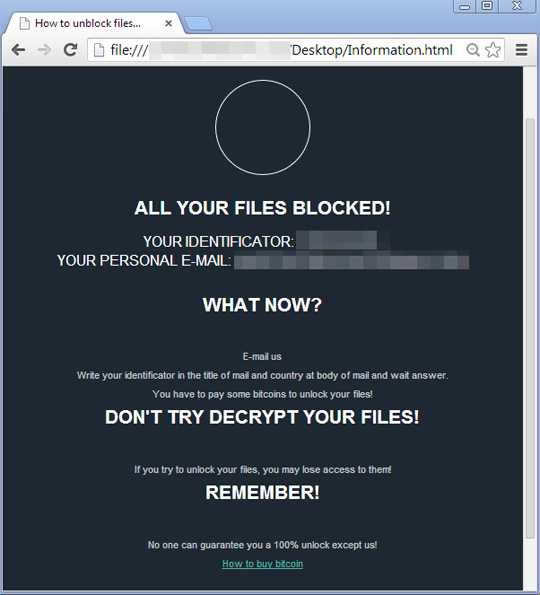Ransom.Win32.MEGACRYPTOR.THABAOAH
W32/FilecoderPib.E40C!tr.ransom (FORTINET); Trojan-Ransom.FileCoder (IKARUS)
Windows


Threat Type: Ransomware
Destructiveness: No
Encrypted: No
In the wild: Yes
OVERVIEW
This Ransomware arrives on a system as a file dropped by other malware or as a file downloaded unknowingly by users when visiting malicious sites.
It encrypts files with specific file extensions. It drops files as ransom note.
TECHNICAL DETAILS
Arrival Details
This Ransomware arrives on a system as a file dropped by other malware or as a file downloaded unknowingly by users when visiting malicious sites.
Installation
This Ransomware adds the following processes:
- cmd.exe /c %User Profile%\DECRYPT.html
- cmd.exe /C timeout /T 15 /NOBREAK && del {malware path}\{malware name} /F
(Note: %User Profile% is the current user's profile folder, which is usually C:\Documents and Settings\{user name} on Windows 2000(32-bit), XP, and Server 2003(32-bit), or C:\Users\{user name} on Windows Vista, 7, 8, 8.1, 2008(64-bit), 2012(64-bit) and 10(64-bit).)
It adds the following mutexes to ensure that only one of its copies runs at any one time:
- bip
Other System Modifications
This Ransomware adds the following registry entries:
HKEY_CURRENT_USER\Software\Microsoft\
Windows\CurrentVersion\Run
inf = %User Profile%\Information.html
HKEY_LOCAL_MACHINE\SOFTWARE\Microsoft\
Windows\CurrentVersion\Run
inf = %User Profile%\Information.html
Other Details
This Ransomware does the following:
- It encrypts files in all drives.
Ransomware Routine
This Ransomware encrypts files with the following extensions:
- .gdb
- .ldf
- .mdf
- .mdb
- .fdb
- .mde
- .txt
- .png
- .jpg
- .jpeg
- .bmp
- .gif
- .zip
- .rar
- .1cd
- .sql
- .bak
- .back
- .cab
- .log
- .ico
- .old
- .rtf
- .lnk
- .doc
- .docx
- .xls
- .xlsx
- .tif
- .vsc
- .mkv
- .flac
- .der
- .sch
- .crt
- .pem
- .pbix
- .hbk
- .epx
- .dpl
- .bpl
- .htm
- .csv
- .mp4
- .mp3
- .myi
- .myd
- .xml
- .r11
- .vsl
- .newdb
- .srf
- .pst
- .ods
- .erf
- .html
- .php
- .asp
- .aspx
- .ppt
- .pptx
- .java
- .cpp
- .css
- .jar
- .swift
- .shtml
- .less
- .sass
- .dat
- .json
- .key
- .avi
- .3gp
- .wmv
- .accdb
- .rmvb
- .mpg
- .mov
- .vob
- .flv
- .swf
- .wma
- .aac
- .mmf
- .amr
- .m4a
- .m4r
- .ogg
- .mp2
- .wav
- .pcx
- .tga
- .tiff
- .odt
- .dll
- .exe
- .lrf
- .glf
- .msi
- .vhdx
- .vhd
- .bin
- .vsv
- .tib
- .vue
It renames encrypted files using the following names:
- {encrypted file}.bip
It drops the following file(s) as ransom note:
- {encrypted directory}\Information.html

SOLUTION
Step 1
Before doing any scans, Windows 7, Windows 8, Windows 8.1, and Windows 10 users must disable System Restore to allow full scanning of their computers.
Step 2
Note that not all files, folders, and registry keys and entries are installed on your computer during this malware's/spyware's/grayware's execution. This may be due to incomplete installation or other operating system conditions. If you do not find the same files/folders/registry information, please proceed to the next step.
Step 3
Delete this registry value
Important: Editing the Windows Registry incorrectly can lead to irreversible system malfunction. Please do this step only if you know how or you can ask assistance from your system administrator. Else, check this Microsoft article first before modifying your computer's registry.
- In HKEY_CURRENT_USER\Software\Microsoft\Windows\CurrentVersion\Run
- inf = %User Profile%\Information.html
- inf = %User Profile%\Information.html
- In HKEY_LOCAL_MACHINE\SOFTWARE\Microsoft\Windows\CurrentVersion\Run
- inf = %User Profile%\Information.html
- inf = %User Profile%\Information.html
Step 4
Search and delete these files
- {encrypted directory}\Information.html
Step 5
Scan your computer with your Trend Micro product to delete files detected as Ransom.Win32.MEGACRYPTOR.THABAOAH. If the detected files have already been cleaned, deleted, or quarantined by your Trend Micro product, no further step is required. You may opt to simply delete the quarantined files. Please check the following Trend Micro Support pages for more information:
Step 6
Restore encrypted files from backup.
Did this description help? Tell us how we did.

